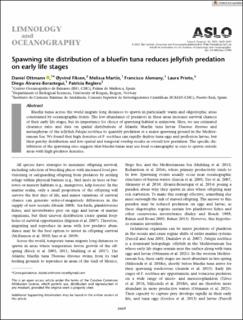Spawning site distribution of a bluefin tuna reduces jellyfish predation on early life stages
Ottmann, Daniel; Fiksen, Øyvind; Martín, Melissa; Alemany, Francisco; Prieto, Laura; Álvarez-Berastegui, Diego; Reglero, Patricia
Journal article, Peer reviewed
Published version

Åpne
Permanent lenke
https://hdl.handle.net/11250/2990530Utgivelsesdato
2021Metadata
Vis full innførselSamlinger
- Department of Biological Sciences [2235]
- Registrations from Cristin [9791]
Sammendrag
Bluefin tunas across the world migrate long distances to spawn in particularly warm and oligotrophic areas constrained by oceanographic fronts. The low abundance of predators in these areas increases survival chances of their early life stages, but its importance for choice of spawning habitat is unknown. Here, we use estimated clearance rates and data on spatial distributions of Atlantic bluefin tuna larvae Thunnus thynnus and metaephyrae of the jellyfish Pelagia noctiluca to quantify predation at a major spawning ground in the Mediterranean Sea. We found that high densities of P. noctiluca can rapidly deplete tuna eggs and preflexion larvae, but their patchy distribution and low spatial and temporal overlap results in overall low predation. The specific distribution of the spawning sites suggests that bluefin tunas may use local oceanography as cues to spawn outside areas with high predator densities.
